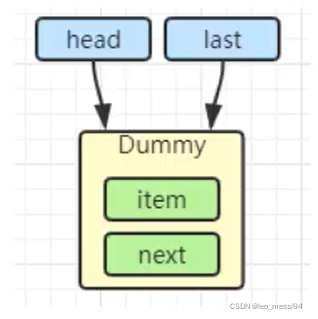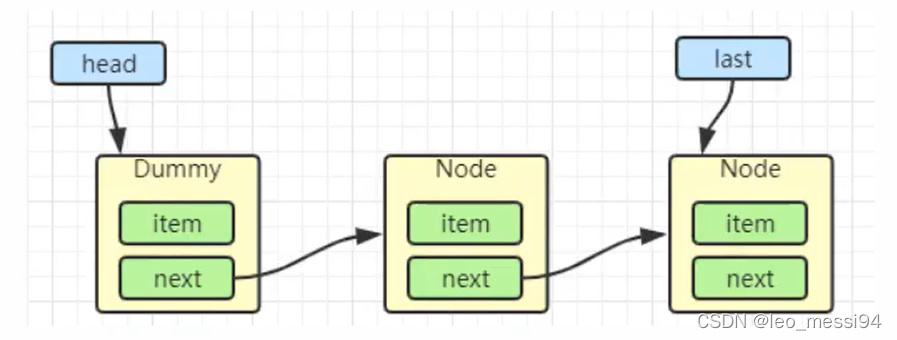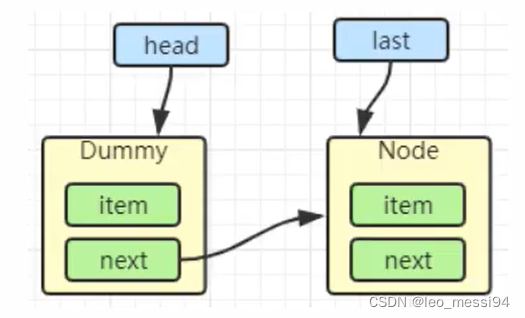LinkedBlockingDeque:
内部维护的节点对象:
public class LinkedBlockingDeque<E>
extends AbstractQueue<E>
implements BlockingDeque<E>, java.io.Serializable {
/** Doubly-linked list node class */
static final class Node<E> {
/**
* The item, or null if this node has been removed.
*/
E item;
// JDK13中的,jdk8没有
/**
* One of:
* - the real predecessor Node
* - this Node, meaning the predecessor is tail
* - null, meaning there is no predecessor
*/
// Node<E> prev;
/**
* One of:
* - the real successor Node
* - this Node, meaning the successor is head
* - null, meaning there is no successor
*/
/**
* 下列三种情况之
* - 真正的后继节点
* - 自己,发生在出列时
* - null, 表示是没有后继节点,是最后了
/
Node<E> next;
Node(E x) {
item = x;
}
}
}
入队:
1.初始化链表:
last = head = new Node< E >(null);Dummy节点(哨兵节点)来占位(last和head都指向dummy节点),item为null

2.第一个节点入队:
last = last.next = node;
把新节点赋值为当前last节点的后节点,并把last节点设置为当前节点

3.第二个及之后的节点入队:
last = last.next = node;

出队:
Node<E> h = head;
Node<E> first = h.next;
h.next = h;
head = first;
E x = first.item;
first.item = null;
return x;
1. Node h = head
将临时变量h赋值给头节点

2. first = h.next;
将临时变量first赋值给h的下一个

3. h.next = h
将h的next指向自己,目的是不让next指向其他节点,保证此节点能安全的被垃圾回收

4. head = first

5.
E x = first.item;
first.item = null;
return x;

加锁分析:
高明之处在于加了2把锁:
- 用一把锁,同一时刻,最多只允许有一个线程(生产者或消费者,二选一)执行
- 用两把锁,同一时刻可以允许2个线程同事(一个生产者一个消费者)执行
- 消费者与消费者线程仍然串行
- 生产者与生产者线程仍然串行
线程安全分析:
- 当节点总数大于2时(包括dummy节点),putLoc保证的是last节点的线程安全,takeLock保证的是head节点的线程安全。两把锁保证了入队和出队没有竞争
- 当节点总数等于2时(即一个dummy节点,一个正常节点)这时候,仍然是两把锁锁两个对象,不会竞争
- 当节点总数等于1时(就一个dummy节点),这时take线程会被noteEmpty条件阻塞,有竞争,会阻塞
// 用于put(阻塞), offer(非阻塞)
private final ReentrantLock putLock = new ReentrantLock();
// 用于take(阻塞),poll(非阻塞)
private final ReentrantLock takeLock = new ReentrantLock();
put操作
public void put(E e) throws InterruptedException {
// 不能为空
if (e == null) throw new NullPointerException();
// Note: convention in all put/take/etc is to preset local var
// holding count negative to indicate failure unless set.
int c = -1;
LinkedBlockingQueue.Node<E> node = new LinkedBlockingQueue.Node<E>(e);
final ReentrantLock putLock = this.putLock;
// count维护元素计数
final AtomicInteger count = this.count;
// 可打断
putLock.lockInterruptibly();
try {
/*
* Note that count is used in wait guard even though it is
* not protected by lock. This works because count can
* only decrease at this point (all other puts are shut
* out by lock), and we (or some other waiting put) are
* signalled if it ever changes from capacity. Similarly
* for all other uses of count in other wait guards.
*/
// 队列容量满了,就等待
while (count.get() == capacity) {
// 倒过来读:等待不满
notFull.await();
}
// 有空位,入队且计数加一
enqueue(node);
// 返回的是+1前的值
c = count.getAndIncrement();
if (c + 1 < capacity)
// 除了自己put以外,队列还有空位,由自己唤醒之前等待的put线程
// 一次只唤醒一个,避免不必要的竞争
notFull.signal();
} finally {
putLock.unlock();
}
// 如果队列中中一个元素,叫醒take线程
if (c == 0)
// 一次只唤醒一个,避免不必要的竞争
signalNotEmpty();
}
take操作
和put类型,不做分析
和Array性能比较:
主要列举LinkedBlockingQueue(推荐)和ArrayBlockingQueue的性能比较
- Linked支持有界,Array强制有界
- Linked实现是链表,Array是数组
- Linked是懒惰的,而Array需要提前初始化Node数组
- Linked每次入队会生成新Node,而Array的Node是提前创建好的
- Linked两把锁,Array一把锁
ConcurrentLinkedQueue:
ConcurrentLinkedQueue的设计和LinkedBlockingQueue非常像,也是:
- 两把锁,同一时刻,可以允许两个线程(一个生产者一个消费者)执行
- dummy节点的引入让两把锁将来锁住的是不同对象,避免竞争
- 只是这锁使用了cas来实现
事实上,ConcurrentLinkedQueue应用还是非常广泛的:
例如之前讲的Tomcat的Connector结构时,Acceptor作为生产者向Poller消费者传递事件信息时,正是采用了ConcurrentLinkedQueue将ScoketChannel给Poller使用:
